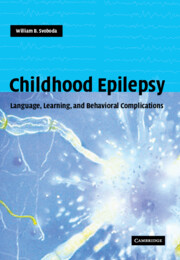Book contents
- Frontmatter
- Contents
- Preface
- Glossary
- 1 Looking ahead
- Part I Speech and language problems
- Part II Learning problems
- 12 Learning challenges
- 13 The development of learning
- 14 Learning difficulties
- 15 Learning problems with seizure types
- 16 Modifying factors
- 17 Transient cognitive impairments of epilepsy
- 18 Attention and alertness
- 19 Memory
- 20 Executive functioning
- 21 Academics
- 22 Antiepileptic medication effects
- 23 Effects of other therapies
- 24 Diagnosis
- 25 Gaining help
- 26 Frustrations of learning problems
- Part III Behavior problems
- Index
- References
12 - Learning challenges
from Part II - Learning problems
Published online by Cambridge University Press: 26 October 2009
- Frontmatter
- Contents
- Preface
- Glossary
- 1 Looking ahead
- Part I Speech and language problems
- Part II Learning problems
- 12 Learning challenges
- 13 The development of learning
- 14 Learning difficulties
- 15 Learning problems with seizure types
- 16 Modifying factors
- 17 Transient cognitive impairments of epilepsy
- 18 Attention and alertness
- 19 Memory
- 20 Executive functioning
- 21 Academics
- 22 Antiepileptic medication effects
- 23 Effects of other therapies
- 24 Diagnosis
- 25 Gaining help
- 26 Frustrations of learning problems
- Part III Behavior problems
- Index
- References
Summary
Roughly half of children with epilepsy experience increased school difficulties due to retardation, intellectual decline, learning disabilities, and underachievement (Rutter et al., 1970; Stores, 1978; Stores, 1987; Thompson, 1987; Aldenkamp et al., 1990; Smith et al., 2002). They falter and fail due to the affects of the seizures and seizure discharges, the seizure cause, and the medications (Aldenkamp, 1983; Reynolds, 1985; Wiberg et al., 1987; Blennow et al., 1990; Henricksen, 1990). Often, their difficulties are undiagnosed, misdiagnosed, or missed. Consequently, although the seizures may cease, the patient enters into the adult world unprepared and underemployed.
International experience
Over the past 50 years, numerous studies have been done in the USA and in Europe regarding the experiences of children with epilepsy in school. A representative sampling of the findings shows that needs exist.
Schooling
Problems of learning and behavior are over-represented in children with epilepsy. A majority (69%) of children with epilepsy attending ordinary schools have a below-average level of performance. Some (21%) show behavior disturbances (Holdsworth & Whitemore, 1974; Mellor & Lowint, 1977).
Teachers perceive children with epilepsy as having poor concentration and mental processing and to be less alert than their peers (Bennett-Levy & Stores, 1984). More than 50% of children with epilepsy are reported by their teachers as “just holding their own” in ordinary schools at a below-average level, whereas one-sixth fall behind seriously (Holdsworth & Whitemore, 1974).
Problems
Performance problems fall into four groups: retardation, declining intelligence, learning disabilities, and underachievement. Performance impairments are noted.
- Type
- Chapter
- Information
- Childhood EpilepsyLanguage, Learning and Behavioural Complications, pp. 161 - 170Publisher: Cambridge University PressPrint publication year: 2004



